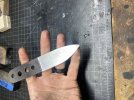- Joined
- Jun 1, 2019
- Messages
- 211
Hello all, I am trying like hell to get a full flat grind down and I am riding the struggle bus hard. Here is what I am doing.
First things first I am using a jig...Relatively new and just feel more comfortable. I am scribing 2 center lines, 20 thousands apart. Grinding 45 degrees into the scribe line Freehand. Then I throw it on a jig and calculate my angle using Dan Comeau Angle calculator....What I am left with though is a saber grind. In theory the angle should take the grind down to the spine, but I hit the center line before I am anywhere close. Is my angle wrong? Do I need to just keep walking the angle down more?
Any advice would be great.
First things first I am using a jig...Relatively new and just feel more comfortable. I am scribing 2 center lines, 20 thousands apart. Grinding 45 degrees into the scribe line Freehand. Then I throw it on a jig and calculate my angle using Dan Comeau Angle calculator....What I am left with though is a saber grind. In theory the angle should take the grind down to the spine, but I hit the center line before I am anywhere close. Is my angle wrong? Do I need to just keep walking the angle down more?
Any advice would be great.

